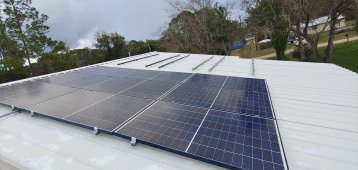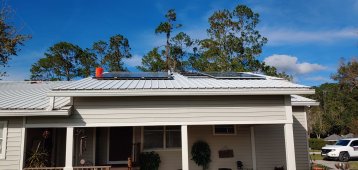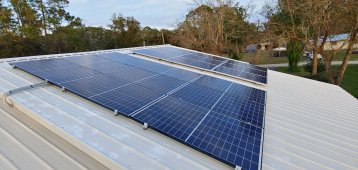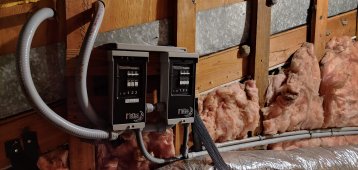MrM1
I'm Here, But I'm Not All There
Been working on it and planning it for a while. And it just so happened to work out that the day I actually finished the job was also my Birthday ... today ?
I have a single Midnite Solar Classic 150. For the past four years it has been just fine with a MS Classic Sizing Tool sized array. With my 24v system, I was able to use REC 285w panels in a 3s3p arrangement. Input voltage is around 104v dc.
But upgrading to a 690Ah 8s3p LFP battery bank, cloudy days, and winter days were not seeing full charge. No big deal ... LFP, but I did discover you can over panel the MS Classic. The resources here, and also email conversations with Midnite Tech said it was no problem to double the size of the array. So I found a deal on 9 REC 290w panels (same model ~ TwinPeak II ~ and almost exactly speced the same as my 4 year old 285s) so I picked them up back in Oct. Finally got around to installing them this past week, wired up them to the new MS 3 string combiner box home run last night, and connected them to the PV busbar in the MS ePanel this morning with the original array.
"Flipped the switch" at 9:15am this morning. The original array was producing 555 watts, The new array was producing 420 watts (some shading still on that side) and the total array was up to 1015 watts at 9:15am. Nice. Nearly double the morning production.
Long store short, the end result was pretty much as expected. By 10:30am I was up to 2600 watts, and 94 amps from the Classic ~ which is it's max. The weather was partly cloudy. I only saw 1800 watts the day before wiht the old array in blue skys at solar noon. So all was good. At 2600 watts and 94 amps the Classic began to clip as expected. As Midnite tech had told me, this will not hurt the Classic, it would just not use the extra power. I switched off both arrays one at a time to see what I was really producing. Some where around 3100 watts was my real production, but I knew the Classic would not and could not use it all. That's OK.
My only issue was a little more heat than i have ever seen on the FETs. MS Tech told me the Classic would not dissipate the extra power as heat, it just would not use it, In the past I have only every been able to get no more than 60ish amps of charging from my old array. This new double array hits 94 amps even on meh days. So the SCC is running pretty much wide open 94 amps for 3-5 hours per day. The FETs, which I have never seen getting above 65c where running at 85c +.
Everything went great and worked exactly as expected. This gives me what I wanted, a 5131 watt array that will produce 94 amps (the Classics Max at 24v) and will do it all day for 4-5 hours a day. But I am wondering, are temps being upwards of 90c on the FETs a bad thing? I was getting 48c on the case even with an external fan (that I have had installed for years). I read that Mosfets can do 175c but really start shortening their life at 125c (but this info was not specifically SCC data). I have no idea.
I am considering using Midnite's Charge Current Limiting programing feature (not the same as the output current setting). This would limit charging amps, but would not limit load amps if needed. Most of the time the hi amps will be from charging as I seldom use much load thru the day.
But what are your thoughts on FETs getting upwards of 90c on the classic? Is that just the result of the Classic outputing 94 amps or is it also do to over paneling? Should I Limit charge current some to off set this heat? Would that help? What would be an acceptable FET temp for 4-6 hours a day? ( my other option is a second classic obviously) Responses appreciated. @Robin Gudgel @SpongeboB Sinewave
Here's some install Shots (new array is in the back of the pic)
ProSolar Racking


Both Arrays: 3s3p. Old is 2565w / New is 2610w

New Combiner box and home run ready for a 2nd Classic if I ever decide to go down that road.
(right now both are feeding a single classic)

With Midnite Solar ... It's Always Fun and Easy. ?
I have a single Midnite Solar Classic 150. For the past four years it has been just fine with a MS Classic Sizing Tool sized array. With my 24v system, I was able to use REC 285w panels in a 3s3p arrangement. Input voltage is around 104v dc.
But upgrading to a 690Ah 8s3p LFP battery bank, cloudy days, and winter days were not seeing full charge. No big deal ... LFP, but I did discover you can over panel the MS Classic. The resources here, and also email conversations with Midnite Tech said it was no problem to double the size of the array. So I found a deal on 9 REC 290w panels (same model ~ TwinPeak II ~ and almost exactly speced the same as my 4 year old 285s) so I picked them up back in Oct. Finally got around to installing them this past week, wired up them to the new MS 3 string combiner box home run last night, and connected them to the PV busbar in the MS ePanel this morning with the original array.
"Flipped the switch" at 9:15am this morning. The original array was producing 555 watts, The new array was producing 420 watts (some shading still on that side) and the total array was up to 1015 watts at 9:15am. Nice. Nearly double the morning production.
Long store short, the end result was pretty much as expected. By 10:30am I was up to 2600 watts, and 94 amps from the Classic ~ which is it's max. The weather was partly cloudy. I only saw 1800 watts the day before wiht the old array in blue skys at solar noon. So all was good. At 2600 watts and 94 amps the Classic began to clip as expected. As Midnite tech had told me, this will not hurt the Classic, it would just not use the extra power. I switched off both arrays one at a time to see what I was really producing. Some where around 3100 watts was my real production, but I knew the Classic would not and could not use it all. That's OK.
My only issue was a little more heat than i have ever seen on the FETs. MS Tech told me the Classic would not dissipate the extra power as heat, it just would not use it, In the past I have only every been able to get no more than 60ish amps of charging from my old array. This new double array hits 94 amps even on meh days. So the SCC is running pretty much wide open 94 amps for 3-5 hours per day. The FETs, which I have never seen getting above 65c where running at 85c +.
Everything went great and worked exactly as expected. This gives me what I wanted, a 5131 watt array that will produce 94 amps (the Classics Max at 24v) and will do it all day for 4-5 hours a day. But I am wondering, are temps being upwards of 90c on the FETs a bad thing? I was getting 48c on the case even with an external fan (that I have had installed for years). I read that Mosfets can do 175c but really start shortening their life at 125c (but this info was not specifically SCC data). I have no idea.
I am considering using Midnite's Charge Current Limiting programing feature (not the same as the output current setting). This would limit charging amps, but would not limit load amps if needed. Most of the time the hi amps will be from charging as I seldom use much load thru the day.
But what are your thoughts on FETs getting upwards of 90c on the classic? Is that just the result of the Classic outputing 94 amps or is it also do to over paneling? Should I Limit charge current some to off set this heat? Would that help? What would be an acceptable FET temp for 4-6 hours a day? ( my other option is a second classic obviously) Responses appreciated. @Robin Gudgel @SpongeboB Sinewave
Here's some install Shots (new array is in the back of the pic)
ProSolar Racking


Both Arrays: 3s3p. Old is 2565w / New is 2610w

New Combiner box and home run ready for a 2nd Classic if I ever decide to go down that road.
(right now both are feeding a single classic)

With Midnite Solar ... It's Always Fun and Easy. ?
Last edited:


